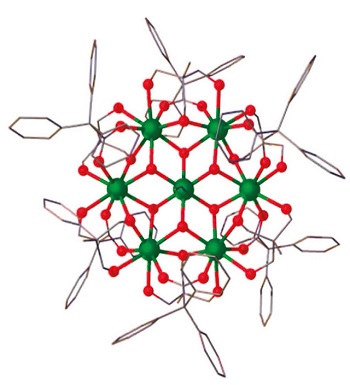An international team of researchers from the University of Manchester, Bielefeld University and the Universidad de Zaragoza have successfully reached temperatures of one Kelvin above absolute zero using magnetic molecules, in an experiment known as sub-Kelvin cooling.
 The magnetic molecule ‘Gd7’ used in the low-temperature experiment has the geometric structure of a snowflake. Photo: Nature Communications
The magnetic molecule ‘Gd7’ used in the low-temperature experiment has the geometric structure of a snowflake. Photo: Nature Communications
Obtaining temperatures in the low Kelvin range are possible when helium is used as a refrigerant. However, helium is not found abundantly and the helium-3 isotope capable of achieving temperature to few tenths of 1K is very expensive.
It is also possible to use magnetic substances as refrigerants such as paramagnetic salts. The cooling of these substances is independent of pressure. A decrease in the electromagnetic field generated by an electromagnet causes the paramagnetic salts to cool down.
The research team used magnetic molecules which contained magnetic ions such as gadolinium.
The magnetic molecule used by the researchers is known as Gd7 due to its geometric shape which resembles a snowflake.
The computer simulations show that the molecules cool in a reducing magnetic field and then they again warm up before they cool down again when the magnetic field disappears.
Gd7 behaves in more complicated ways when compared to paramagnetic salts in which temperature drop is continuous as the magnetic field reduces. Hence it is possible to use Gd7 molecules to reach very low temperatures without completely turning off the magnetic field.
Nowadays, these can be produced in large quantities so that they are readily available compared to helium.
Professor Eric J. L. McInnes PhD, University of Manchester
Jürgen Schnack has been researching magnetic molecules for 15 years. These often have an organic backbone including hydrogen, carbon and oxygen in which special metal ions like iron ions are linked together. This research was published in the journal Nature Communications.